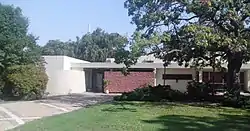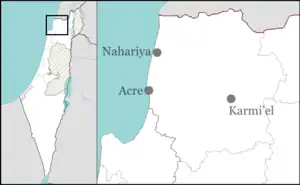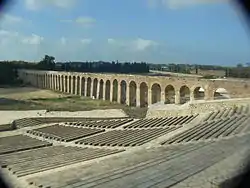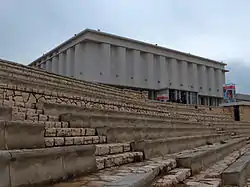Lohamei HaGeta'ot
Lohamei HaGeta'ot (Hebrew: לוֹחֲמֵי הַגֵּיטָאוֹת, lit. The Ghetto Fighters) is a kibbutz in northern Israel. Located in the western Galilee, it falls under the jurisdiction of Mateh Asher Regional Council. In 2021 it had a population of 816.[1]
Lohamei HaGeta'ot
לוֹחֲמֵי הַגֵּטָאוֹת | |
|---|---|
 | |
| Etymology: Ghetto fighters | |
 Lohamei HaGeta'ot  Lohamei HaGeta'ot | |
| Coordinates: 32°57′46″N 35°5′45″E | |
| Country | |
| District | Northern |
| Council | Mateh Asher |
| Affiliation | Kibbutz Movement |
| Founded | 1949 |
| Founded by | Surviving fighters of the Warsaw Ghetto Uprising, former Jewish partisans and other Holocaust survivors. |
| Population (2021)[1] | 816 |
History
The kibbutz was founded by Holocaust survivors in 1949 on the coastal highway between Acre and Nahariya, on the site of an abandoned British Army base[2] and the depopulated Palestinian village of al-Sumayriyya.[3] Its founding members include surviving fighters of the Warsaw Ghetto Uprising (notably Yitzhak Zuckerman, ŻOB deputy commander), as well as former Jewish partisans and other Holocaust survivors. Its name commemorates the Jews who fought the Nazis.[4]
Historian Tom Segev describes Zvi Dror's four-volume history of the lives of the Holocaust survivors who founded the kibbutz as one of the most important books ever written about Holocaust survivors in Israel."[5] Anita Shapira, who translates the title as "Testimony pages," describes Dror's book as "one of the first projects to coax the mute to speak" about the Holocaust.[6]
Leon Uris spent a week interviewing residents of the kibbutz and recording their experiences as part of his research for the novel Exodus. [7]
Economy
In the mid-1980s the kibbutz acquired the Tivall vegetarian food products factory, which has become a mainstay of its income. Other branches include a large dairy and agriculture and a bed and breakfast. The kibbutz is currently undergoing a process of privatization. It operates a bed and breakfast for tourists to the area.
Archaeology
Alongside the kibbutz are the extensive remains of an aqueduct which supplied water to Acre some 6 km away, until 1948. The aqueduct was originally built at the end of the 18th century by Jezzar Pasha, the Ottoman ruler of Acre, but was completely rebuilt by his successor, Suleiman, in 1814.[8]

Museum
The kibbutz operates the Ghetto Fighters' House, a history museum commemorating those who fought the Nazis. Adjacent to the museum is a large amphitheater used frequently for concerts, assemblies, and ceremonies hosted by the museum.

Notable people
References
- "Regional Statistics". Israel Central Bureau of Statistics. Retrieved 22 February 2023.
- יום מרד הגיטו בקיבוץ ע"י לוחמיו (in Hebrew). Retrieved 2017-10-15.
- Khalidi, Walid (1992). All That Remains: The Palestinian Villages Occupied and Depopulated by Israel in 1948. Washington D.C.: Institute for Palestine Studies. pp. 30–31. ISBN 0-88728-224-5.
- "מוזיאון בית לוחמי הגטאות".
- Segev, Tom (11 May 2005). "Once a Palmachnik, Always a Palmachnik". Haaretz. Retrieved 12 May 2019.
- Shapira, Anita (31 January 1998). "The Holocaust: Private Memories, Public Memory". Jewish Social Studies. 4 (2): 40–58. doi:10.2979/JSS.1998.4.2.40.
- Leon Uris: Life of a Best Seller, Ira B. Nadel
- Moreh Derech trip report